To Serve My People: Part II
Arthur Szyk saw the face of Haman. It was Hitler. And he knew what had to be done. His only tools were his art and he labored mightily against the terrible enemy. In the early 1930’s Szyk took up the Haggadah as his weapon. As Tom Freudenheim comments in his essay on Szyk (“Freedom Illuminated: Understanding the Szyk Haggadah,” 2008), “Nonetheless, Szyk understood that Passover is itself a political holiday–commemorating liberation from slavery, and that it is insistent on the importance–the obligation–of retelling a narrative that is as much (perhaps more) political as it is theological.”
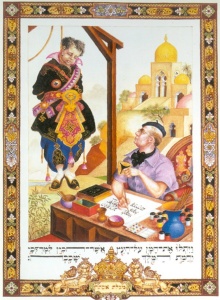
As we saw last week in the first part of this review the Szyk Haggadah alternates between traditional illustrations of events in the Haggadah: a religious family is poised to begin their seder; and Szyk’s unique commentary on passages utilizing select Biblical narratives: Abraham Entertaining the Three Angels illuminating “This is the bread of our affliction” as a comment on the mitzvah of welcoming guests and feeding the poor. When he does this he startles us with an unfamiliar juxtaposition and thereby creates a double-tiered commentary with his images. First of all “This is the bread of our affliction” is transformed into a command to welcome guests and the poor to our seder table. Secondly the next time we read the verse “Looking up, he saw three men standing over him” (Genesis 18:2) we will visualize Szyk’s image of three yeshiva lads with white fluffy wings and remember that the midrash tells us that this happened at Passover.
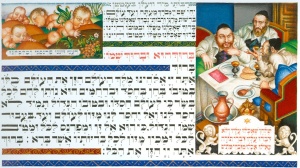
If Dayyeinu can be visually conflated with a thankful David after defeating Goliath, perhaps it is not too much of a stretch that the Grace After Meals is introduced with an image of little babies abandoned in a field seeking sustenance from some kind of miraculous rocks. This refers to the midrash that relates when the pregnant Jewish women attempted to escape Pharaoh’s murderous decree they delivered their children in the fields and abandoned them there. God in His mercy sent cakes of honey and oil to sustain them, hence we thank God for our more mundane sustenance when we say Grace. This image is combined with another at the top of the page showing three religious Jews heatedly discussing something at their seder table. The framed text informs us from Pirkei Avos 3:4 that “Three who have eaten at one table and have not spoken words of Torah, it is as if they have eaten offerings to dead idols.” It is as if Szyk is warning us: “Stop! If after the first part of the Haggadah you occupied your seder meal with family gossip, small talk and current events, you absolutely must elevate your conversation to include the Torah themes of this momentous night. Talk Torah before you continue with the Grace and the rest of the Haggadah!” What we see here is the power of the visual image to recast what we think we know so well.
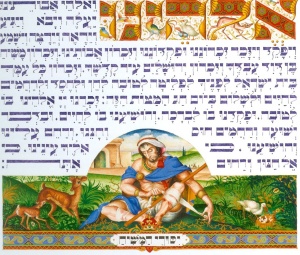
Among the more startling of Szyk’s images is “The Sufferings of the Messiah” showing a battered savant bandaging his injured leg, staff at the ready, surrounded by gazelles and a heron (phoenix) with its chicks. Reflecting Sanhedrin 98a he is sitting at the entrance of a town, but in Szyk’s image bandaging himself rather than “poor lepers, all of them untie them all at once and rebandage them together, whereas he unties and rebandages each separately.” The Haggadah reference is to the holiday addition of “May there ascend, come, reach and appear… the remembrance of the Messiah, son of Your servant David…” and Szyk causes us to focus on the Messianic undertone in the Grace after Meals, especially on this Passover night when we so yearn for Elijah to walk in the door and announce the Messiah and return to our Land.
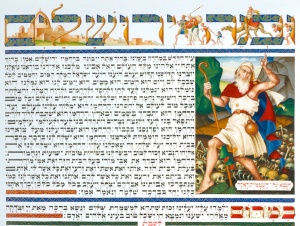
Szyk continues to break new ground in the oft-repeated Grace After Meals introducing an image of Ezekiel trudging through The Valley of Dry Bones linking it with “The Compassionate One! May He break the yoke of oppression from our necks and guide us to our Land.” The vision of the Dry Bones culminates in God saying “Behold, I open your graves and raise you up from your graves, O’ My people, and I shall bring you to the soil of Israel.” (Ezekiel 37:12) The restoration of the Jewish people to the Land of Israel is certainly present in the Grace After Meals, especially in the blessing of “He who rebuilds Jerusalem.” Szyk expands it to a messianic vision that simultaneously refers to Ezekiel and modern Zionism.
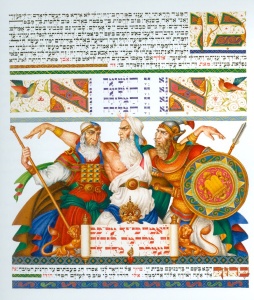
After Grace After Meals the Haggadah continues with the Hallel, climaxing with the moving passage; “Please, Hashem, Save Now; Please Hashem, Bring Success Now!” Szyk in a half page illumination returns us to the Biblical narrative with Hur and Aaron supporting Moses’ arms during that first battle with Amalek. Moses is seen as determined and concentrated on his mission of divine supplication while Aaron and Hur are steadfast in their role as faithful supporters. At this moment in the Hallel we must summon the emotions to feel that our very fate was hanging in the balance, just as with Moshe, Aaron and Hur. The artist guides us there.
At the formal end of the Haggadah Szyk continues to surprise us with Biblical commentary. Just as Szyk begins his Haggadah with an invocation to never forget Jerusalem, the Haggadah proper ends with the proclamation “Next Year in Jerusalem!” His image is of Ruth and Naomi embracing; Ruth affirming her love of God and the Jewish people: “Where you go I will go, and where you stay I will stay. Your people will be my people and your God my God.” (Ruth 1:16). Such a fantastic commitment can only be made by an outsider, by someone determined to preserve the newly discovered treasure of Jewishness. Szyk understood that only by love and steely determination would the Jewish people survive to return to their land and see the advent of the Messiah.
Szyk’s Haggadah itself has returned from the past, emerging as a newly published 2008 edition lovingly recreated by Irvin Ungar published by Historicana. Under his supervision all the original artwork was digitally reproduced in state of the art ink-jet prints creating an entirely new and superior version of the 1940 original. The new translation and commentary by Byron L. Sherwin elucidates the complex role Szyk’s images play as the Haggadah unfolds.
After Szyk finished and published his Haggadah in 1940 he threw himself into countless efforts to save the Jews of Europe. He worked feverously for the Emergency Committee to Save the Jewish People of Europe and after the war devoted himself to the creation of the State of Israel. His anti-fascist and anti-totalitarian political satires, cartoons and caricatures flourished as well as numerous commissions and book projects. In May 1948 he proudly became an American citizen. Shockingly in 1951 he was investigated by the House Un-American Activities Committee under the suspicion of being involved with Communist front organizations. In September 1951 he suffered a heart attack and died at the age of 57.
Arthur Szyk had seen the face of Haman. It was Hitler. And he knew what had to be done and he did it. His Haggadah is a testament to freedom, kindness and determination in the face of oppression. The events of the Haggadah heralded the creation of the State of Israel and the freedom of the Jewish people. Szyk did his part.
Szyk Haggadah
To Serve My People: Part II
www.szyk.com